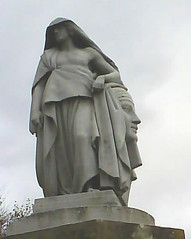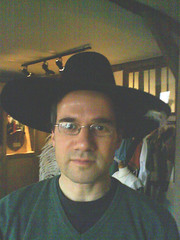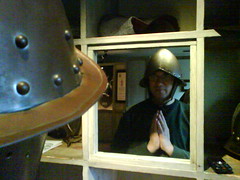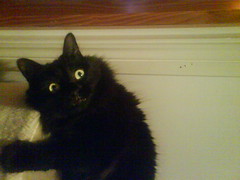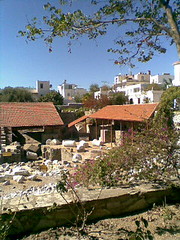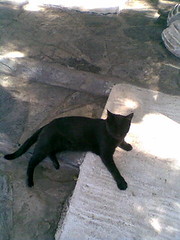(One chum was telling me just a while ago that he’s given up any pretence of keeping up with his mates’ stuff. It is easier and cheaper and probably less cruel than to keep on saying, “But I mean to.”)
But my current employment means a couple of hours commuting, which means I’m fast catching up. I’ve also just had this two-week stint extended to 21 December, so I’m afraid there’s going to be quite a lot more book posts to come. Sorry.
Robert Shearman’s Tiny Deaths is a collection of 14 short stories all on the subject of death. The final story, “Somewhere in a small room a little boy sat waiting”, is the only one I’d read before, when it appeared in the Benny anthology Life During Wartime, edited by Paul Cornell. (Alongside TWO stories of mine, because clearly I am best.)
In the context of Tiny Deaths, it’s a very different story. No longer is it implicit that the small boy in question is the half-doggy son of a space archaeologist, hidden away while the museum-on-a-planetoid that’s his home is invaded by space-Nazis. Instead, we only get things as he understands them, so there are hints of something happening that means he must be hidden, and that Mummy is somehow involved.
Reading it in this new context, I realised the story had no especially science-fiction elements to it. The events could almost be happening anywhere, any when – and it’s that universality that makes it so affecting. (Interestingly, to me anyway, Cornell gave me notes once that Benny stories should always be noticeably sci-fi.)
It’s tricky to discuss the rest of Tiny Deaths without spoiling it’s many wondrous surprises. Like a lot of Rob’s plays on stage and on Radio 4, there’s a prevailing bitter-sweetness to the stories, with wry comic detail punctuating the sense of loss. On the back cover, Martin Jarvis compares him to Douglas Adams, Alexei Sayle and Philip K Dick. I also thought of Alan Bennett.
The cover – a lovely thing of a Goth girl blowing bubbles that are also holes – is a great summing up of this light-touch melancholia. It occurs to me as I write this that she only needs an ankh and she could be Neil Gaiman’s fun, lively Death.
Often Rob’s characters are rather numb to the things happening to them – people who aren’t in love or aren’t grieving, or don’t quite understand all the fuss. This leads them to attempt to explain themselves, which is a good device for creating a skewed perspective. It also means that many of the stories have a dream-like quality.
Another thing that makes them dream-like is the strict adherence to the rules of fantasy. Like his celebrated Doctor Who work, Rob will start a story from some mad idea – everyone suddenly all being told how and when they’re going to die, or that Hell does not discriminate between its human souls and those of other animals. And having established this “novum” (which is what the clever academic Darko Suvin calls the weirdshit that’s crucial to sci-fi), he then explores its consequences on ordinary people.
As Douglas Adams famously said, the effect of following this weirdshit through is that an idea that’s initially silly and funny becomes something affecting, and moving, and scary. Stranger still, the mad ideas become somehow plausible, even convincing. By changing the rules of sacred stuff we yet take so for granted – how we die, how we grieve, how we are thought of afterward – Rob undermines our sureties. As a result, it’s an unsettling sequence, at once playful and profound.
Again, it’s difficult to describe this without giving anything away, and the stories are full of quite brilliant veerings off. But the titular story is a particular gem. It begins with a description of Jesus not as an ordinary person as such, but at least as one we feel we might almost have known. He’s good on scripture, the story explains, but not brilliant on practicalities.
“As his parents had said, somewhat ruefully, there was a lad who knew the value of everything and the cost of nothing […] He’d listen patiently as his disciples at the Last Supper tried to tot up the bill and work out how much everyone should put in – they should just split it thirteen ways Andrew had suggested, but Simon Peter pointed out that was all very well but he hadn’t had a starter, and Thomas went on to say that he had had a starter but it had only been olives, that was the cheapest thing on the menu, that hardly counted, in some restaurants they’d be thrown in gratis, it was hardly his fault this one didn’t. And Jesus would say nothing, just watch them indulgently, would wait until he was told what his contribution should be, and put in without further comment.”
Robert Shearman, “Tiny Deaths”, in, er, Tiny Deaths, pp. 175-6.
It’s a story that’s at once deliciously blasphemous and yet at the same time dares to give insight on what Jesus’ death means. There’s both something of The Last Temptation about it, yet also of Life of Brian.And in struggling to explain what the book’s like, I realise I’m just listing other things I’ve loved. Which is about as a good a recommendation as you’re going to get.
